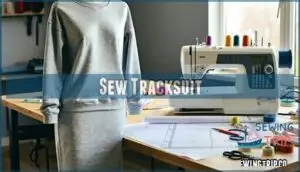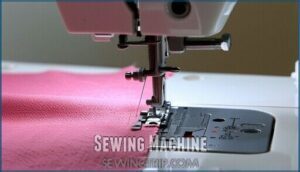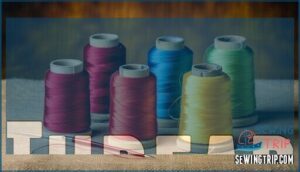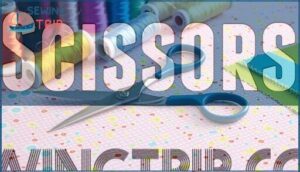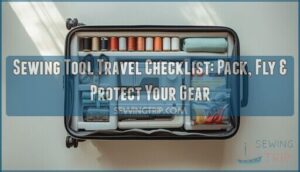This site is supported by our readers. We may earn a commission, at no cost to you, if you purchase through links.

Cut your pieces using a free or purchased pattern, making sure to adjust for your measurements. Use a sewing machine with a zigzag stitch, as it handles stretch fabrics well.
Sew the pants and jacket, starting with seams, then move to details like cuffs or an elastic waistband. Don’t forget to finish raw edges to prevent fraying.
Adding details like zippers or pockets? Measure twice, sew once—it saves headaches! For pro tips on adjustments or fit, stay tuned for advanced tweaks.
Table Of Contents
Key Takeaways
- Use stretchy, durable fabrics like sweatshirt fleece or jersey knit, and pre-wash them to prevent shrinkage.
- A zigzag stitch on your sewing machine works well for stretch fabrics if you don’t have a serger.
- Reinforce stress points, like pockets, with bartacks and use quality thread and elastic for a long-lasting finish.
- To ensure a perfect fit, make pattern adjustments and test with muslin mockups before sewing your final tracksuit.
Sew Tracksuit
Anyone can sew a tracksuit with the right approach! Start by choosing durable tracksuit fabric like sweatshirt fleece or jersey for long-lasting wear.
With the right fabric and tools, creating a stylish, durable tracksuit is easier than you think!
Use a zigzag stitch if you don’t have a serger—it works well for stretch fabrics. Follow a simple tracksuit sewing pattern, and reinforce pockets with bartacks for added strength.
For cuffs, stretch slightly while attaching to guarantee a snug fit. Finish hems neatly with stretch stitches or twin needles.
For a professional touch, consider using a serger to finish seams. With a little effort, your DIY tracksuit will look and feel amazing!
Materials Needed
To make a tracksuit, you’ll need the right materials to guarantee a comfortable fit and clean finish.
Gather stretch fabric, elastic, matching thread, a sewing machine, pins, and sharp scissors to get started.
Fabric
When choosing tracksuit fabric, think about durability and comfort—it’s the foundation of your project.
Durability and comfort are the heart of crafting a tracksuit—choose fabrics that support both style and lasting strength effortlessly.
Stretch fabrics like sweatshirt fleece and jersey knits are perfect since they offer flexibility and a polished look.
Look for these qualities:
- Fabric Durability: Opt for medium to heavy-weight fabrics for long-lasting wear.
- Stretch Factor: Select materials with good recovery to maintain shape.
- Fiber Content: Try cotton blends or bamboo for breathability and softness.
Pre-wash the fabric to account for shrinkage and guarantee color fastness, preventing surprises later.
Consider exploring different tracksuit material options to find the perfect match for your project.
This attention to detail makes sewing knit fabric easier and results in better-fitting tracksuits.
Elastic
When picking elastic for your tracksuit, think comfort and durability.
An elastic waistband should fit snugly without digging in.
Elastic widths matter—2 inches works well for waistbands, while ¾ to 1 inch suits ankle hems.
Elastic types, like braided or knit varieties, offer flexibility and style.
Verify the length fits your sizing, and try stretching it gently to check quality.
Consider exploring options for a tracksuit elastic waistband for more specialized choices.
A comfortable elastic waist makes all the difference!
Sewing Machine
Using a sewing machine makes sewing a tracksuit easier and guarantees a polished finish.
Adjust the tension for stretch fabrics, use the right needle for knit fabrics, and select the correct presser feet.
Pay attention to stitch settings—zigzag or stretch stitches work best.
Regular machine maintenance keeps your stitches smooth and consistent, making your sewing techniques both reliable and rewarding.
For superior results, consider using ballpoint needles to prevent fabric damage, ensuring your sewing is both reliable and rewarding.
Thread
Switching from the sewing machine setup, let’s talk thread.
Match the thread color to your fabric for a polished look.
Use polyester thread for stretch fabrics like knits—it’s strong and flexible.
Pair it with the right needle size to avoid snags.
Keep thread tension balanced; uneven tension can ruin stitch durability.
Quality thread makes all the difference!
Pins
Keeping your fabric steady is essential when you sew tracksuits, and pins are your trusty helpers.
Use fine, sharp pins to avoid fabric damage, especially with delicate or stretchy materials.
For Pin Placement, align seams and edges precisely, ensuring fabric layers don’t shift.
If you’re new to sewing, explore clips as Pin Alternatives—they’re beginner-friendly.
Always store pins in a magnetic pin holder for safety and easy access.
Consider using specially designed options for delicate fabrics.
Mastering this simple step can sharpen your sewing techniques and build confidence fast!
Scissors
A sharp, reliable pair of scissors is your secret weapon when you sew a tracksuit. Properly cutting fabric guarantees smooth sewing later.
Look for scissors with ergonomic handles for comfort during longer projects. Keep blades sharp for precise cuts and prevent fabric snags. Use fabric-specific scissors for clean edges—avoid using them on paper!
Maintain them by wiping blades after use and storing them in a safe place.
- Blade Type: Choose stainless steel for durability.
- Ergonomic Handles: Reduce hand strain.
- Cutting Techniques: Use long, steady strokes.
- Maintenance Tips: Clean blades regularly.
- Scissor Types: Fabric shears or thread snips work best.
Free Pattern
Free patterns make sewing tracksuits simple and budget-friendly.
Start by exploring options like Anna The Tailor’s hoodie and trackpants or Sewing by Mrs L’s tapered pants. These come with beginner-friendly instructions and videos.
Before printing, check for accuracy—many patterns include a test square to verify sizing is correct. Look for features like seam allowance markings and size adjustments for style customization.
Patterns often allow personalization, meaning you can tweak designs for a perfect fit. It’s a beginner-friendly project with satisfying results!
Adjusting Fit
Nailing the fit of your tracksuit hinges on thoughtful tweaks.
Start with these tips:
- Pattern Alterations – Adjust patterns for proper fit on your unique body measurements.
- Length Adjustments – Shorten or lengthen hems using muslin mockups to test changes.
- Waist Fitting – Modify elastic for snug yet comfortable waistbands through size grading.
- Comfort Adjustments – Adapt seams and guarantee ease in movement without tightness.
- Pocket Reinforcements – Bartack stitch near pockets for durability during wear.
Personalize confidently for a seamless garment fitting!
Tools Used
A good sewing setup makes magic happen. Use a sewing machine for precision and durable seams.
Serger benefits include tidy edges and stretch-friendly finishes.
Rotary cutters pair well with a cutting mat for clean, straight cuts. Needle selection matters—choose stretch or ballpoint for knits.
MumCraft Clips replace pins, keeping fabrics secure. Keep scissors sharp for fabric-only cutting. A Kam Tool simplifies snaps and grommets.
Pair matching thread with pins or sewing clips to handle fabrics smoothly while enhancing accuracy and confidence.
| Tool | Purpose | Key Feature | Suggested Use |
|---|---|---|---|
| Serger | Edge finishing | Stretch-friendly seams | Knits and stretchy fabric |
| Rotary Cutter | Cutting fabric | Clean, straight cuts | Large fabric pieces |
| MumCraft Clips | Securing fabric | Pin alternative | Thick or layered fabric |
| Kam Tool | Installing snaps & grommets | Quick and simple setup | Track pants customization |
Reader Interactions
Sharing your journey in our sewing community can boost your progress.
Swap Fit Feedback and Style Suggestions to refine your easy tracksuit. Show off in Project Showcases to inspire others tackling this beginner sewing project.
Need Pattern Modifications? Ask! Everyone’s here to help. Tweaking an easy tracksuit design? Share your tips!
Sewing’s all about collaboration, so don’t sew in silence. A tracksuit tutorial might guide you, but community Skill Sharing turns ideas into mastery—because creativity grows when it’s shared.
To further boost your skills, consider encouraging kids to sew and sharing your knowledge with them.
Frequently Asked Questions (FAQs)
How Do I Know if I Need a Serger for This Project?
Think of a serger like adding sprinkles to a cupcake—it’s not required, but it elevates the result.
Use one if you want strong seams, professional finishes, and reduced fraying on stretchy fabrics.
How Do I Adjust the Pattern for Different Sizes?
To adjust patterns for different sizes, modify key measurements like waist, hips, and inseam.
Use a ruler, adjust seams proportionally, and create test pieces for fit.
Gradual tweaks guarantee comfort without losing the original style.
Are There Any Additional Techniques I Can Use to Make the Tracksuit More Durable?
Reinforce seams with double stitching or serging to prevent fraying.
Add bartacks at stress points like pockets.
Pre-wash fabric to reduce shrinkage, and use high-quality elastic and thread for long-lasting wear and durability.
Is This Project Suitable for Beginners?
Yes, it’s suitable!
Start with simple patterns and stretchy fabric like sweatshirt fleece.
Use zigzag stitches if you lack a serger.
Follow instructions carefully, and pre-test fit adjustments.
Patience and practice make progress!
Are There Any Other Fabric Options I Could Use?
You could use ponte knit, scuba, or interlock fabric for tracksuits.
They offer good stretch and structure, perfect for activewear.
Just pre-wash to avoid surprises later, especially with shrinkage.
Stay comfy and sew away!
What fabric is used for tracksuits?
Tracksuits typically use stretchy, durable fabrics like sweatshirt fleece, knit blends, or polyester.
You’ll want material with some give for movement and comfort, yet strong enough to hold up during workouts or lounging, using durable fabrics.
What material can I use to sew joggers?
It’s ironic how joggers require fabric that "flexes" on command—opt for stretchy materials like sweatshirt fleece, bamboo jersey, or cotton blends.
These fabrics provide comfort, durability, and movement, perfect for those casual yet active vibes.
What material should a tracksuit be?
Pick soft, stretchy fabrics like sweatshirt fleece, bamboo jersey, or knit blends.
These offer comfort and durability. Make certain the material has enough stretch for movement, and pre-wash to avoid shrinkage.
Quality guarantees long-lasting wear!
What makes a tracksuit a tracksuit?
Picture lounging in effortless comfort, your tracksuit hugs your body with stretch fabric, elastic waistband, and cuffs.
It’s designed for mobility, snug yet breathable, blending function and style for workouts, errands, or cozy downtime.
How do I know if I need a serger for this project?
You don’t absolutely need a serger, but it makes seams stronger and prevents fraying.
If you’re using stretch fabrics, a zigzag or stretch stitch on a regular sewing machine works just fine.
Conclusion
Sewing a tracksuit isn’t rocket science—it’s about planning, patience, and precision.
With the right stretchy fabric, a reliable zigzag stitch, and attention to details like hems and fit, you’ll have a custom outfit that’s both stylish and practical.
Remember, measure twice before cutting or adding features like zippers.
Take each step carefully, and don’t skip finishing raw edges.
Now that you know how to sew tracksuit basics, you’re ready to tackle your next sewing challenge!

